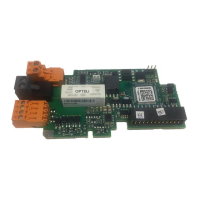6
vacon • 34 Commissioning
Local contacts: https://www.danfoss.com/en/contact-us/contacts-list/
Example 3: OPTBJ board with SS1 and safety reset or EN 60204-1 stop category 1.
The figure above presents a connection example of OPTBJ board for SS1 safety function with ex-
ternal safety relay module and with safety reset.
The external safety relay module is connected to the switch S1. The used power supply to switch S1
is 230 VAC as an example. The safety relay module is connected to OPTBJ board with 4 wires as
shown in Figure above.
To configure the drive to perform the fast deceleration with a ramp, it is recommended to use Quick
Stop -function that is activated by digital input, for example DI6 as in Example 3 above. See the ap-
plication manual for correct parametrization of Quick Stop -function.
When the switch S1 is activated (contacts open), the drive starts ramping down the output frequency
until the delay of the safety relay has passed. After safety relay time delay, the drive goes to STO
state. If the motor is still running, it stops by coasting. If STO fault action is parameterized as
"Alarm", the drive indicates: "30 Safe torque off". Regardless of the parameterization, activation of
STO function causes a coasting stop for motor.
To allow the returning of the drive to ready state after S1 is deactivated (contacts closed) and safety
relay is resetted, STO Fault action needs to be parameterized as "Alarm". If STO Fault action is pa-
rameterized as "Fault", also the drive needs to be reset to allow ready state. See application manual
for related parameters.
To start the motor operation again, following sequence is performed.
• Release the switch S1 (contacts closed). The hardware is now enabled and the drive returns to ready
state. An alarm indication for STO actiavation is displayed if STO Fault action is parameterized as
"Alarm".
• Acknowledge the releasing of switch by resetting the safety relay. The drive returns to the ready state.
• Giving a valid start command starts running the motor

